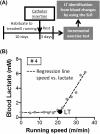Memory persistence enhancement by post-learning moderate exercise requires de novo protein synthesis in the dorsal hippocampus
- PMID: 40679969
- PMCID: PMC12273956
- DOI: 10.1371/journal.pone.0328128
Memory persistence enhancement by post-learning moderate exercise requires de novo protein synthesis in the dorsal hippocampus
Abstract
Acute moderate-intensity exercise (AME) after learning has been reported to exogenously boost consolidation of hippocampus-dependent memory, resulting in improved long-term persistence. However, the neuronal mechanism remains poorly understood. Short-term, hippocampus-dependent memory produced by weak encoding can be transformed into long-term memory through an immediate, strong behavioral event, which causes overlapping activation of the hippocampus. Hippocampal de novo protein synthesis is essential for achieving memory consolidation in this way. As AME activates the hippocampus, enhanced memory consolidation through post-learning AME may also be mediated by protein synthesis in the hippocampus. To test this hypothesis, this study first attempted to establish a rat model for enhancing memory consolidation via post-learning AME with the object location (OL) test, a hippocampus-dependent spatial memory task. This study used adult male Sprague-Dawley rats, and the AME load was based on the running speed corresponding to the rats' lactate threshold (20 m/min) for 20 min. We then examined the effects of the protein synthesis inhibitor anisomycin (ANI), injected into the dorsal hippocampus, on AME-induced OL memory consolidation. In the OL test, the OL memory encoded with 5 min of learning was retained for at least 1 hr but was lost after 24 hr. With a single bout of AME immediately after the 5 min of OL learning, the memory persisted for 24 hr, indicating AME-induced memory consolidation. The AME-induced OL memory consolidation did not occur when ANI was injected into the dorsal hippocampus immediately or 4 hr after OL learning. These findings support the hypothesis that post-learning AME-induced memory consolidation depends on new-protein synthesis in the dorsal hippocampus and highlight the value of AME after learning as a strategy for enhancing memory consolidation. This is a potential base model for future research examining the mechanism behind boosting memory consolidation with exercise.
Copyright: © 2025 Inoue et al. This is an open access article distributed under the terms of the Creative Commons Attribution License, which permits unrestricted use, distribution, and reproduction in any medium, provided the original author and source are credited.
Conflict of interest statement
The authors have declared that no competing interests exist.
Figures






Similar articles
-
Short-Term Memory Impairment.2024 Jun 8. In: StatPearls [Internet]. Treasure Island (FL): StatPearls Publishing; 2025 Jan–. 2024 Jun 8. In: StatPearls [Internet]. Treasure Island (FL): StatPearls Publishing; 2025 Jan–. PMID: 31424720 Free Books & Documents.
-
Sexual Harassment and Prevention Training.2024 Mar 29. In: StatPearls [Internet]. Treasure Island (FL): StatPearls Publishing; 2025 Jan–. 2024 Mar 29. In: StatPearls [Internet]. Treasure Island (FL): StatPearls Publishing; 2025 Jan–. PMID: 36508513 Free Books & Documents.
-
The Black Book of Psychotropic Dosing and Monitoring.Psychopharmacol Bull. 2024 Jul 8;54(3):8-59. Psychopharmacol Bull. 2024. PMID: 38993656 Free PMC article. Review.
-
Comparison of Two Modern Survival Prediction Tools, SORG-MLA and METSSS, in Patients With Symptomatic Long-bone Metastases Who Underwent Local Treatment With Surgery Followed by Radiotherapy and With Radiotherapy Alone.Clin Orthop Relat Res. 2024 Dec 1;482(12):2193-2208. doi: 10.1097/CORR.0000000000003185. Epub 2024 Jul 23. Clin Orthop Relat Res. 2024. PMID: 39051924
-
Management of urinary stones by experts in stone disease (ESD 2025).Arch Ital Urol Androl. 2025 Jun 30;97(2):14085. doi: 10.4081/aiua.2025.14085. Epub 2025 Jun 30. Arch Ital Urol Androl. 2025. PMID: 40583613 Review.
References
MeSH terms
Substances
LinkOut - more resources
Full Text Sources
Medical
Research Materials

